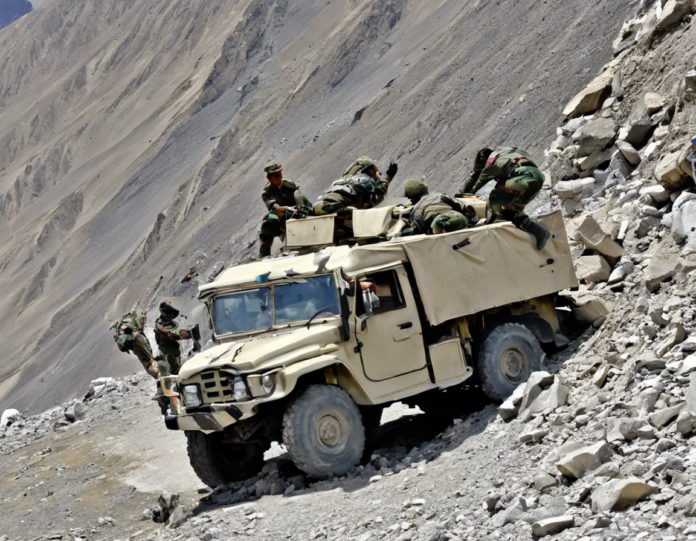The Leh Ladakh Army accident that recently took place on a treacherous high-altitude road in the Indian Himalayas has sent shockwaves across the nation. This tragic incident has once again brought the spotlight on the challenges faced by the armed forces in ensuring the security of the borders in these inhospitable terrains.
The Incident
On the fateful day of July 14, 2021, a convoy of the Indian Army comprising a total of 18 personnel was on its way from the base camp in Leh to a nearby location when disaster struck. One of the military vehicles, a transport truck, carrying soldiers plunged into a deep gorge near the Tangtse area in Eastern Ladakh. The rugged terrain coupled with inclement weather conditions exacerbated the situation, making rescue operations difficult and challenging.
Casualties
Tragically, the accident resulted in the loss of lives of 18 brave soldiers, with only one soldier miraculously surviving the ordeal. The news of this heart-wrenching incident left the entire nation mourning the loss of these valiant soldiers who made the ultimate sacrifice in the line of duty.
Causes of the Accident
While investigations are still ongoing to determine the exact cause of the accident, initial reports suggest that the slippery road conditions due to rain might have played a significant role in the tragic incident. The challenging topography of the region, with its narrow roads and steep cliffs, adds to the complexity of driving in such areas, especially during adverse weather conditions.
Importance of Army Operations in High-Altitude Areas
High-altitude areas like Leh Ladakh hold strategic importance for the armed forces due to their proximity to the border with China. These regions pose unique challenges, including extreme weather conditions, lack of infrastructure, and difficult terrain, making military operations a daunting task. Despite these challenges, the Indian Army remains vigilant and committed to defending the nation's borders, often operating in harsh and demanding environments.
Safety Measures and Precautions
In the aftermath of such a devastating accident, there is a renewed focus on safety measures and precautions that need to be taken while navigating treacherous mountainous terrains. The importance of proper training, adhering to safety protocols, regular maintenance of vehicles, and ensuring real-time weather updates cannot be overstated in such challenging environments.
Resilience and Sacrifice
The brave soldiers of the Indian Army stationed in these high-altitude regions epitomize resilience, dedication, and sacrifice. Despite facing constant threats and adversities, they continue to perform their duties with unwavering commitment and valor. Their selfless service and unparalleled bravery serve as a beacon of inspiration for the entire nation.
Conclusion
The Leh Ladakh Army accident serves as a stark reminder of the perils faced by the armed forces in safeguarding the nation's borders, especially in arduous terrains like the Himalayas. It underscores the need for constant vigilance, robust safety measures, and the undying spirit of our soldiers who stand guard in the harshest of conditions. As a nation, it is imperative for us to honor the memory of the fallen heroes and support the brave men and women in uniform who continue to protect our sovereignty with unwavering dedication and valor.
Frequently Asked Questions (FAQs)
Q: What were the circumstances leading to the Leh Ladakh Army accident?
A: The accident occurred when a military vehicle carrying soldiers veered off the road and plunged into a gorge near the Tangtse area in Eastern Ladakh.
Q: How many casualties were reported in the Leh Ladakh Army accident?
A: The tragic incident resulted in the loss of lives of 18 soldiers, with only one survivor.
Q: What are the challenges faced by the armed forces in high-altitude areas like Leh Ladakh?
A: Challenges include extreme weather conditions, difficult terrain, lack of infrastructure, and the need for constant vigilance in border defense.
Q: What safety measures can be taken to prevent such accidents in mountainous regions?
A: Safety measures include proper training, adherence to safety protocols, regular vehicle maintenance, and staying informed about weather conditions.
Q: How important are high-altitude areas like Leh Ladakh for national security?
A: High-altitude areas play a crucial role in national security due to their proximity to sensitive borders and strategic significance.
Q: How can the nation show support for the armed forces stationed in challenging terrains?
A: The nation can show support through appreciation, welfare initiatives, and ensuring the well-being of military personnel and their families.
Q: What qualities do the soldiers stationed in high-altitude areas exemplify?
A: Soldiers in such regions showcase resilience, dedication, sacrifice, and unwavering commitment to their duties despite facing adversities.
Q: How can the armed forces enhance safety protocols in mountainous regions after such accidents?
A: The armed forces can enhance safety protocols through rigorous training, advanced equipment, regular drills, and continuous improvement based on learnings from past incidents.
Q: What lessons can be learned from the Leh Ladakh Army accident to prevent similar tragedies in the future?
A: The incident underscores the importance of prioritizing safety, infrastructure development, real-time monitoring, and continuous training to mitigate risks in challenging terrains.
Q: How can the nation commemorate the lives of the soldiers lost in the Leh Ladakh Army accident?
A: The nation can pay tribute through memorials, honoring their sacrifice, supporting their families, and upholding the values of courage and valor that define our armed forces.


Recent comments